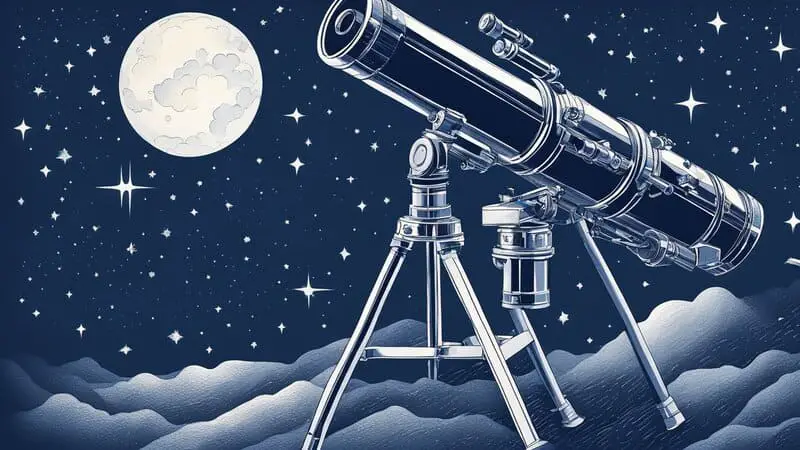Stargazing offers a majestic journey into the wonders of the universe, providing relaxation and a profound sense of connection to the cosmos.
However, with the numerous considerations, from picking the right spot and ensuring vehicle dependability to battling nature’s unpredictability, many enthusiasts need help with their safety.
Is Stargazing Safe?
Yes, stargazing can be a safe and enriching experience when done right. It’s crucial to pick locations with minimal light pollution, use the right tools, and be prepared for nature’s unpredictability. Proper precautions lead to memorable celestial encounters.
In this comprehensive guide, I’ll demystify the art and science of stargazing, sharing essential safety and stargazing tips, tools, and best practices to help you enjoy the celestial dance with confidence and peace of mind.
Key Takeaways:
- Location is Everything: Dive deep into the secrets of choosing the ultimate stargazing spot with minimal light pollution and maximum celestial wonder.
- Solo Stargazing? Stay Safe: Unearth valuable safety mantras for those embarking on a solitary journey under the stars.
- Gear Up Like a Pro: Discover the must-haves for a breathtaking stargazing experience, from essential apps to binoculars.
Let’s dive right in.
Recommended For You
Safety First: Top 7 Tips for Stargazing

Below are my essential safety tips that every stargazer, from novice to expert, should consider.
- Weather Awareness: Prepare for temperature drops and unexpected storms, especially in remote locations.
- Navigation: Save coordinates on your GPS or compass to ensure you can navigate to your stargazing site without getting lost.
- Vehicle Preparedness: Ensure your vehicle is dependable to handle nature’s unpredictability.
- Dress Appropriately: Dress in layers and check weather forecasts to ensure a comfortable experience.
- Wildlife Preparedness: Be aware of the surrounding wildlife. Having deterrents on hand is crucial for safety.
- Solo Safety: Solo stargazers should carry a personal location device and inform someone about their plans.
- Digital Safety: With popular stargazing apps, consider digital privacy concerns. Connectivity issues might arise in remote locations.
Venturing Into the Stars: Where and How?

Secrets to Picking the Ultimate Safe Location For Stargazing
When I choose a stargazing spot, I always consider factors like light pollution, accessibility, and the right observation time. One often overlooked hazard is the potential encounter with wildlife or unforeseen terrain issues.
My stargazing secrets include:
- Rural vs. urban locations: Your best bet is to venture away from urban areas and head for a more rural setting, where light pollution is minimized.
- Light pollution maps and mobile apps: Utilize mobile apps for location scouting and light pollution maps to determine the ideal area for unobstructed night sky viewing.
- Local observatories and astronomy sites: Connect with local observatories or astronomy groups to get insider knowledge on the best stargazing spots in your area.
The best stargazing is in remote locations, away from city lights. The downside is that these areas can be more dangerous because they are remote. There are many safety precautions to take, but one is to tell your family and friends exactly where you are going and to have the location finder set on your phone or geo-family app.
You should also tell them when you plan to return. Call someone when you head out and tell them you will call them when you head back. Make the call after your return, or at least on the way back, so they know you’re safe.

Orthodontist, Windermere Orthodontics
FREE STARGAZING CHECKLIST
My 5-page Stargazing Checklist will enhance your astronomical observations.
Follow this free checklist to navigate the night sky with confidence, clarity, and a sense of preparedness for a rewarding stargazing experience.

Travel with Assurance: Ensuring Vehicle Dependability
I’ve found transportation a pivotal aspect of my stargazing journeys, having once been stranded miles away from home.
- Check your fuel: Before embarking on your adventure, ensure your vehicle has enough fuel to get you to your chosen location and back.
- GPS and navigation tools: Save the coordinates on your GPS or compass to ensure you can easily navigate to your stargazing site without getting lost.
- Accessibility considerations: Be mindful of weather conditions or road restrictions that may affect your travel; staying safe while exploring the cosmos is essential.
Follow the above tips to enjoy stargazing and breathtaking views of the night sky.
Prepare for changes in weather; you can experience rapid weather changes in remote areas. Temperature drops and unexpected storms can cause problems and make it difficult to live in remote locations. You should dress in layers to stay warm, bring extra clothing, and have rain gear on hand. Since the weather can change at any time, you should have the necessary items with you.
These items include sufficient water, snacks, and, most importantly, a first-aid kit. Be prepared for every adverse situation in advance because it is possible that you won’t easily find necessary items in remote locations. Stay safe and enjoy the beauty of the location where you are.

By Saikat Ghosh
Associate Director of HR and Business, Technource
Battling Nature’s Curveballs: Are You Ready?
Dressing for the Celestial Dance: Weather-wise Tips
From my numerous night expeditions, I can’t stress enough how dressing appropriately is vital to safely enjoying stargazing. The weather can be unpredictable, so always check weather forecasts before heading out. Seasonal attire is essential, with UV protection and moisture-wicking fabrics ideal for summer nights.
Here’s a quick list to help you prepare:
- Spring/Fall: Layered clothing, a light jacket, hat, gloves, and warm socks
- Summer: Lightweight and moisture-wicking clothes with sun protection
- Winter: Insulated layers, a heavy coat, waterproof boots, and thermal gloves
Wildlife Under the Stars: Encounters and Safety Measures
During one of my stargazing sessions, I encountered a curious raccoon, reminding me that being outdoors at night always comes with unexpected wildlife encounters. Familiarize yourself with the animals in your area and understand their behavior.
Here are some tips for safe stargazing near potential wildlife:
- Set up a safe zone: Use a tent or enclosed area to protect you from unexpected visitors.
- Be prepared: Carry insect repellent and a first aid kit for potential animal encounters.
- Wildlife deterrents: Consider using noisemakers or bright lights to keep curious animals at bay.
Remember, your safety comes first. With proper preparation and knowledge, you can embrace nature’s curveballs and enjoy a memorable night under the stars.
One safety precaution when stargazing in remote locations is to be aware of the surrounding wildlife.
For instance, in certain regions, encounters with dangerous animals like bears or coyotes can threaten one’s safety. To mitigate this risk, it is vital to research and understand the local fauna before embarking on any stargazing trip. One must learn about potential animal behavior and their preferred habitats.
Additionally, carrying bear spray or other deterrents can provide an added layer of protection if one encounters any unexpected wildlife during their stargazing adventure. By taking these precautions, individuals can enjoy the beauty of the night sky while ensuring their safety in remote locations.

Founder, MarketerInterview.com
Your Starry Toolkit: Equip Like a Pro!

Essentials for the Galactic Trek: What to Bring Along
Over the years, I’ve refined my toolkit, making it perfect for those who love driving out into the wilderness in the summer to find the best spots to go stargazing. I got many of these suggestions from my local astronomy club, a fantastic community of enthusiasts.
These essential tools have significantly enhanced my experience.
- Star charts and smartphone apps: A trusty star chart or a reliable app like Sky Safari is indispensable if you want to stargaze to identify constellations and celestial objects in the night sky, including the mesmerizing bands of the Milky Way. The modern apps also provide tips on observing a meteor shower and the myriad of stars in the sky. Every sky object you can see.
- Red flashlight: When you’re out under clear skies, a red flashlight will help you navigate and is amazing at preserving your night vision.
- Note-taking tools: A small notepad and pen are handy for recording your observations and favorite celestial sights, especially when spotting different planets or the brightest stars in a low Bortle scale area.
- Hiking: Head up to a good vantage point that can offer some of the most stunning views of the heavens, but always remember to follow safety guidelines.
- Portable seating: A comfortable folding chair or cushion will make your stargazing session more enjoyable.
- Telescopes: A good-quality telescope can bring the stars closer to you. Look for one with a sturdy tripod and easy-to-use controls. While a telescope brings the cosmos closer to you, binoculars offer a wide-field view that can be just as stunning.
- Binoculars: If you’re not ready to invest in a telescope, binoculars are an excellent alternative for sweeping night sky views.
When the Lights Go Out: Dark Adaptation
Having been caught off guard during one of my sessions, I now realize the importance of being confident and prepared in the dark.
Here are some tips for making the most of your stargazing experience:
- Protect your night vision: This means avoiding bright lights and using that red flashlight we mentioned earlier. It can take up to 30 minutes for your eyes to fully adapt to the darkness.
- Layer up: Stay warm by dressing in layers and bringing a warm blanket or a hot beverage. Nighttime temperatures can drop quickly, even if it’s been warm during the day.
- Keep your optics clean: Lenses on telescopes and binoculars can become dirty over time. A simple lens cleaning kit will help you keep your view sharp and clear.
- Practice using your equipment beforehand: Adjusting a telescope or trying to locate a specific star is much easier with some prior practice. Make time to familiarize yourself with your new gear in the daylight.
So, whether you’re a seasoned astro-enthusiast or a budding space explorer, these tips and essentials will help you enjoy a fantastic night of stargazing. Remember to pack your stargazer’s toolkit and confidently venture out under the stars.
The Solo Astronomer: Embrace the Silence Safely

Alone but Alert: Safety Mantras for the Solo Stargazer
Some of my most profound reflections came while stargazing alone, a truly peaceful and rewarding experience. However, safety should always be a priority.
Here are some tips if you’re a solo astronomer:
- Carry a personal location device: These devices can pinpoint your location and be crucial in emergencies.
- Have emergency contacts stored: Inform someone about your stargazing plans and have their contact details readily accessible.
- Set up check-in procedures: Arrange regular check-ins with a trusted person during your stargazing session.
- Invest in a personal alarm: These small devices can deter potential threats and alert others in case of danger.
- Pack essentials: Remember a flashlight, warm clothing, and coffee to keep you alert and comfortable.
By incorporating these safety measures, you can fully enjoy the benefits of solitude and immerse yourself in the beauty of the night sky.
Telling someone about your plans is an important safety step when you want to look at the stars in an unknown location. Sharing your plans with a friend, family member, or park worker gives you more safety if something goes wrong.
If you tell someone where you are and when you expect to be back, they can check on you if they need to. It’s wise to carry a fully charged phone and a simple first-aid kit in an emergency. It’s important to have water, snacks, and clothes that are good for changing weather.
By taking these steps and keeping in touch with someone who knows your plans, you can enjoy viewing while effectively lowering the risks.

By Nick Edwards
Managing Director, Snowfinders
Emotional Waves: The Deep Psychological Impact of the Stars
Stargazing can evoke a strong emotional response. The vastness of the cosmos can lead to feelings of awe, humility, and even existential questioning. However, such experiences can also foster mental well-being.
Here are some tips for harnessing the emotional power of the stars:
- Practice meditation techniques: Incorporate mindfulness exercises while gazing at the stars to help calm your mind and enhance your connection with the universe.
- Explore the benefits of solitude: Use the quiet time contemplating the cosmos as an opportunity for self-reflection and personal growth.
- Take advantage of mental well-being resources: If stargazing brings up overwhelming thoughts or feelings, don’t hesitate to seek professional help or explore support materials.
Remember, stargazing can be a powerful tool for self-exploration and emotional healing. Embrace the silence and let the stars guide you on your journey of personal discovery.
Of Laws and Lands: Navigating the Terrain

Starry Etiquette: Understanding and Respecting Regulations
When venturing out for stargazing, being aware of local and national park regulations is essential. Familiarize yourself with the guidelines, covering aspects like permit requirements, protected wildlife areas, and cultural significance sites. For instance, parks like Olympic National Park, Big Bend National Park, Joshua Tree National Park, and Death Valley National Park have specific regulations to ensure minimal environmental disruption to other visitors.
When stargazing on public lands, consider the importance of environmental conservation. Follow the Leave No Trace principles to minimize your impact on the environment. These guidelines include:
- Dispose of waste properly.
- Leave what you find.
- Respect wildlife and reduce your impact.
Tread Gently: Protecting the Wilderness We Adore
The International Dark Sky Association helps maintain the serenity of these stargazing havens by minimizing light pollution to uphold their tranquility. By adhering to the previously mentioned Leave No Trace guidelines and respecting designated park rules, you contribute to their efforts and help maintain the pristine condition of these areas.
Always remember that these natural treasures are for your enjoyment and future generations. By being a responsible stargazer, you play a role in preserving the exquisite beauty and wonder of the night sky. So, get out there, look up, and appreciate the magic of the cosmos, all while treading gently on our precious planet.
Modern Stargazing: The Digital Frontier

Celestial Tech: Keeping Devices Safe Under the Stars
Smartphone protection is essential when stargazing.
Here are some tips for keeping your devices safe:
- Use a protective case to prevent accidental damage.
- Consider device temperature protection, such as an insulated cover for chilly nights, to keep your phone warm and maintain battery longevity.
- Always bring a portable charger just in case your phone’s battery starts to drain. After all, you wouldn’t want to lose power after finding Orion’s Belt!
Astral Apps: Navigating Data Security in the Open
With popular stargazing apps like Star Walk 2, SkyView, and Stellarium, it’s essential to consider digital privacy concerns:
- Connectivity issues are common in remote stargazing locations, so be prepared for occasional signal loss. Plan by downloading the offline features of your chosen astronomy app.
- Cloud data backups can be a lifesaver when storing astronomical observations. Ensure you’re using secure, encrypted clouds to protect your data.
- Encryption tools can shield your communications with other stargazers, ensuring your position and findings remain safe.
Remember to keep your devices secure and protected as you explore the night sky with digital tools.
Health Among the Heavens: Starry Night Well-being

Sustenance for the Stars: Hydration, Nutrition, and Beyond
Stargazing can be a relaxing and enjoyable experience, but remember to care for your body! Proper hydration is essential, so drink water before, during, and after your session. Bring a reusable water bottle to help you stay quenched as you lose more water in cool, low-humidity environments.
Pack nutritious snacks to keep your energy levels up while marveling at the cosmos. Opt for granola bars, nuts, or dried fruits packed with essential nutrients. Be mindful of allergens when selecting treats to ensure everyone enjoys their time under the stars.
As you gaze at the night sky, stretching your muscles periodically is essential. This can help prevent cramps or soreness and keep you comfortable throughout the stargazing experience.
Some simple stretches include:
- Neck rolls: Tilt your head side to side and in a circular motion
- Shoulder shrugs: Raise and lower your shoulders in a gentle motion
- Leg extensions: Point your toes and then flex your feet to stretch your calf muscles
Night Skies and Light’s Lies: The Impact of Light Pollution
You might be surprised to know that bright city lights can negatively affect your health and your stargazing experience. Excessive artificial brightness, or light pollution, can disrupt your sleep cycle by suppressing the production of the melatonin hormone.
Light pollution also has environmental implications affecting air quality and the natural behaviors of wildlife.
To find the best spot for stargazing and minimize the harmful effects of light pollution, you can use a light pollution map to identify nearby dark sky locations. Websites such as Light Pollution Map can help you locate the perfect spot to fully appreciate the celestial beauty.
Some extra tips to protect your eye health during stargazing include:
- Refrain from staring directly at bright objects for excessive periods
- Take breaks every 20 minutes by refocusing on something in the distance to give your eyes time to rest
- Blink frequently to keep your eyes moist
So, when planning your next stargazing adventure, remember to look after your health and the environment – and enjoy the wonder of the celestial skies.
Frequently Asked Questions
How can I avoid light pollution for the best stargazing experience?
To avoid light pollution and ensure the best stargazing experience, it’s essential to venture away from urban areas to rural settings. Light pollution maps and mobile apps can help identify areas with minimal artificial brightness. Local observatories and astronomy groups can also offer insights into the best spots in your region.
What are some must-have tools for stargazing beginners?
For beginners embarking on a stargazing journey, some must-have tools include a trusty star chart or a reliable smartphone app like Sky Safari to identify constellations. A red flashlight is vital for navigation without disrupting night vision, and a comfortable folding chair or cushion will enhance the experience. For those ready to invest, a good-quality telescope or binoculars can provide sweeping views of the night sky.
How can solo stargazers ensure their safety during nighttime sessions?
Solo stargazers can ensure their safety by carrying a personal location device that can be invaluable during emergencies. Informing someone about your stargazing plans, having their contact details accessible, and setting up regular check-ins are essential. Additionally, a personal alarm can deter potential threats, and packing essentials like a flashlight and warm clothing can ensure a safe and comfortable experience.
Summary: Is Stargazing Safe?
In a nutshell, stargazing is not only about witnessing the beauty of the cosmos but also about prioritizing safety, preparation, and respect for the environment.
Stargazing Safety Tips Summary:
- The Spot Matters: Ideal stargazing locations have minimal light pollution, providing clearer celestial views. Using light pollution maps and apps can guide you to the best spots.
- Gear Up: Essential tools like telescopes, red flashlights, and smartphone apps enhance the stargazing experience. Preparation, including practicing with your gear, is vital.
- Nature’s Elements: Weather can be unpredictable. Dressing in layers and checking forecasts ensure a comfortable experience. Familiarity with local wildlife and having deterrents on hand is crucial for safety.
- Solo Safety: If you’re stargazing alone, personal location devices, emergency contacts, and personal alarms are essential. Consider mental well-being, including using stargazing for meditation and self-reflection.
- Respecting Rules: Being aware of local regulations, respecting the environment, and following “Leave No Trace” principles safeguard natural stargazing havens.
- Digital Tools: Smartphone protection is key. Data security is imperative, even with your favorite stargazing app. Awareness of connectivity issues in remote areas and using encrypted tools protect your digital data.
- Health and Hydration: Remember to hydrate and pack nutritious snacks. Stretching and protecting your eyes from the adverse effects of light pollution ensures physical well-being during stargazing sessions.
In our quest for the cosmos, nothing beats a dark night sky!
While the moon is an incredible sight, its brightness can sometimes overshadow fainter celestial objects. One of the top locations for stargazers is a state park. Even better? An international dark sky park.
International Dark Sky Parks, recognized for their minimal light pollution, are sanctuaries for those seeking the most spectacular views of the universe.
Venturing to the north can also provide unique opportunities to witness phenomena like the Northern Lights. It’s a worthwhile endeavor to research and travel to a dark sky park near you.
Stay Safe, and Happy Stargazing!




